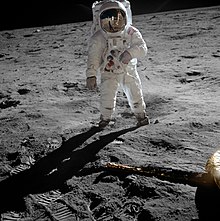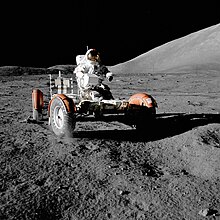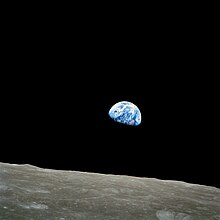
Back Apollo-program AF Programa Apollo AN برنامج أبولو Arabic لمهمة د أپولو ARY Programa Apollo AST Apollon proqramı AZ آپولو پروژه سی AZB Апалон (касмічная праграма) BE Апалён (касьмічная праграма) BE-X-OLD Аполо Bulgarian
 | |
| Program overview | |
|---|---|
| Country | United States |
| Organization | NASA |
| Purpose | Crewed lunar landing |
| Status | Completed |
| Program history | |
| Cost |
|
| Duration | 1961–1972 |
| First flight |
|
| First crewed flight |
|
| Last flight |
|
| Successes | 32 |
| Failures | 2 (Apollo 1 and 13) |
| Partial failures | 1 (Apollo 6) |
| Launch site(s) | |
| Vehicle information | |
| Crewed vehicle(s) | |
| Launch vehicle(s) | |
| Part of a series on the |
| United States space program |
|---|
  |
The Apollo program, also known as Project Apollo, was the United States human spaceflight program led by NASA, which succeeded in landing the first men[2] on the Moon in 1969, following Project Mercury, which put the first Americans in space. It was conceived in 1960 as a three-person spacecraft during President Dwight D. Eisenhower's administration. Apollo was later dedicated to President John F. Kennedy's national goal for the 1960s of "landing a man on the Moon and returning him safely to the Earth" in an address to Congress on May 25, 1961. It was the third US human spaceflight program to fly, preceded by Project Gemini conceived in 1961 to extend spaceflight capability in support of Apollo.
Kennedy's goal was accomplished on the Apollo 11 mission when astronauts Neil Armstrong and Buzz Aldrin landed their Apollo Lunar Module (LM) on July 20, 1969, and walked on the lunar surface, while Michael Collins remained in lunar orbit in the command and service module (CSM), and all three landed safely on Earth in the Pacific Ocean on July 24. Five subsequent Apollo missions also landed astronauts on the Moon, the last, Apollo 17, in December 1972. In these six spaceflights, twelve people walked on the Moon.



Apollo ran from 1961 to 1972, with the first crewed flight in 1968. It encountered a major setback in 1967 when an Apollo 1 cabin fire killed the entire crew during a prelaunch test. After the first successful landing, sufficient flight hardware remained for nine follow-on landings with a plan for extended lunar geological and astrophysical exploration. Budget cuts forced the cancellation of three of these. Five of the remaining six missions achieved successful landings, but the Apollo 13 landing had to be aborted after an oxygen tank exploded en route to the Moon, crippling the CSM. The crew barely managed a safe return to Earth by using the lunar module as a "lifeboat" on the return journey. Apollo used the Saturn family of rockets as launch vehicles, which were also used for an Apollo Applications Program, which consisted of Skylab, a space station that supported three crewed missions in 1973–1974, and the Apollo–Soyuz Test Project, a joint United States-Soviet Union low Earth orbit mission in 1975.
Apollo set several major human spaceflight milestones. It stands alone in sending crewed missions beyond low Earth orbit. Apollo 8 was the first crewed spacecraft to orbit another celestial body, and Apollo 11 was the first crewed spacecraft to land humans on one.
Overall, the Apollo program returned 842 pounds (382 kg) of lunar rocks and soil to Earth, greatly contributing to the understanding of the Moon's composition and geological history. The program laid the foundation for NASA's subsequent human spaceflight capability and funded construction of its Johnson Space Center and Kennedy Space Center. Apollo also spurred advances in many areas of technology incidental to rocketry and human spaceflight, including avionics, telecommunications, and computers.
- ^ "How much did the Apollo program cost?". The Planetary Society. Retrieved March 25, 2024.
- ^ "July 20, 1969: One Giant Leap for Mankind - NASA". July 20, 2019.